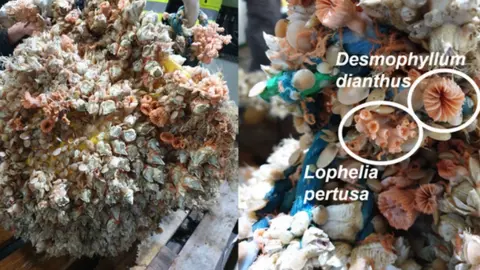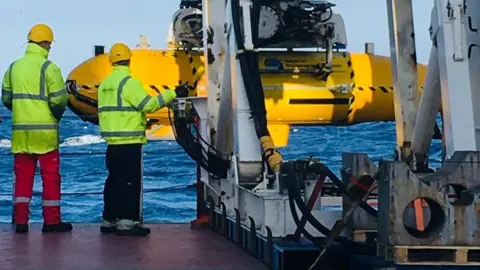New coral growths found at damaged deep sea reef off Scotland
 NOC
NOCNew growths of a rare cold water coral have been discovered for the first time at a deep sea habitat damaged by trawling.
The area called the Darwin Mounds and its coral reefs were discovered off the north of Scotland in 1998.
Following damage caused by bottom trawling, the habitat was later declared a marine protected area.
Scientists have now found coral growing on plates attached to buoys and lowered to the mounds in an experiment in 2011.
There are concerns the reef will struggle to recover because the corals grow so slowly.
A team of scientists and engineers making the first expedition to the mounds in eight years raised the plates and buoys.
They were covered by deep sea animals, including barnacles, brittle stars and predatory worms.
To the team's surprise they found some species of coral had settled onto the buoys, including several colonies of the coral Lophelia pertusa that had arrived from the Darwin Mounds as larvae.
The expedition, which is also using robot submarines to survey the habitat, described this discovery as an "exciting find".
 Cat Wardell
Cat WardellThe team said: "This is good news for the area, and could indicate that recovery could be possible. However, this doesn't immediately mean that everything is perfect.
"We only have collected a very limited amount of seabed imagery so far, which means we don't have the data in hand yet to say if the mounds themselves are recovering or not.
"But it did get the science team pretty excited."
The team is being led by the National Oceanography Centre (NOC) and the University of Southampton.
They are using a 3D imaging system to create a detailed map of the area.
The Darwin Mounds lie 1,000m (3,280ft) beneath the surface of the North Atlantic about 185km (115 miles) off Cape Wrath in Sutherland in the Highlands.
The habitat is an extensive area of sandy mounds, each about 100m (328ft) in diameter and 5m (16ft) high.
In 2003, the area was given Marine Protected Area status to prevent further damage.
